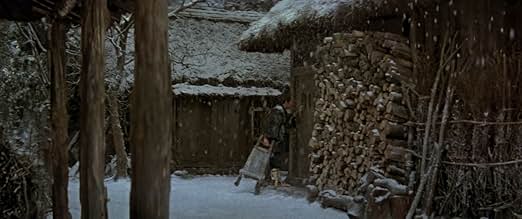IMDb रेटिंग
7.8/10
3.9 हज़ार
आपकी रेटिंग
अपनी भाषा में प्लॉट जोड़ेंA kabuki theatre-inflected story about a poor village whose people have to be carried to a nearby mountain to die once they get old.A kabuki theatre-inflected story about a poor village whose people have to be carried to a nearby mountain to die once they get old.A kabuki theatre-inflected story about a poor village whose people have to be carried to a nearby mountain to die once they get old.
- पुरस्कार
- 6 जीत और कुल 1 नामांकन
कहानी
क्या आपको पता है
- ट्रिवियाThis was the final film to be added to Roger Ebert's list of "Great Movies" before his death on April 4, 2013 at the age of 70.
- कनेक्शनFeatured in Tvennesnack: Varför kan vi inte komma ihåg den här jävla filmen? (2022)
फीचर्ड रिव्यू
The Ballad Of Narayama (aka: Narayam bushiko) is a film by Keisuke Kinoshita, whose directing career stretched over 40 years. In notable fashion it mixes kabuki style balladeer narration and musical accompaniment with a tragic story set around responsibilities of old age, rural hardship, family cruelty and the painful obligations brought by restrictive and conservative social convention. It's a consideration of that which is a characteristic of many films made before, and during, the golden age of Japanese cinema. In the hands of masters like Mizoguchi, for instance, such depictions frequently evolved into profound considerations of the female condition. (In fact star Kinuyo Tanaka, was a favourite of that master, having previously appeared in films like Sansho Dayu and Ugetsu Monogatari.) Narayama is of that old school: an often painful - this viewer for one will long remember the moment when the old woman knocks out her own teeth on the edge of a stone grinder - and frequently moving account of a society which denies dignity to the old but which, at least in one instance, is granted them anyway. Such a traditional style of storytelling all but vanished when a new wave of Japanese directors come to prominence in the following decade. As others have observed the biggest irony of the film is that grandmother Orin is probably the single most productive member of her immediate circle. Of her nearest relatives, as she herself says: "Tatsuhei and Kesakichi are useless" - seen thus, her looming absence is very much a tragedy on both a social, as well as a personal, level.
Much of Narayama's power is drawn from its exquisite staging, an entirely successful recreation of a village environment and surrounding countryside done entirely in the studio. Except for the striking final shots, every part of the film is artificial, including the passing of time, even if emotions evoked thereby are not. Intense character interactions are sometimes emphasised in pools of light, while at another moment the set is lit in an ominous red; painted backcloths occasionally drop to provide transition between one scene and another, while actors end their parts in silhouette as the next action starts up behind them. Close ups are used sparingly, characters typically seen at a distance in their environment, again as on a stage. It is a process unique to this version of the tale, based on the folk story Dumping Grannies. It was one that, incidentally, was not copied over by Imamura in his, also critically successful, 1983 remake of Narayama with the result that that film arguably had a wider international appeal (it won top prize at Cannes).
In a different tradition entirely, the artificiality and expressionism on display in the present version recall that of Kwaidan (1964) a colour horror film where even the sun and sky are painted in dramatic fashion - even though not with quite the intensity. The result of Narayama's very deliberate technique is to emphasise the narrative texture of events as well at the same time to place them firmly within a particularly nationalistic tradition of story telling. It's also a cumulative effect given abrupt contrast by the last scene of the film, which places events back in a modern context.
In the film, moments of pathos and tragedy frequently counterbalance those of formality and ritual, and it's the tension between these two that gives the results power, and their Japanese flavour. This is most notable during the final trip to the mountain, one made by the despairing son carrying his grandmother upwards on his back. It's a long journey both for the principals as well as in actual screen time, as the passage occupies long and frequently silent minutes as they pass deliberately through the artificially crafted landscape. It's one that has been previously described, and its responsibilities circumscribed, by the precise instructions of village elders. But it speaks volumes too as far as the central relationship is concerned; heartbreaking as the mother refuses to communicate during her final hours, and as we see Tatsuhei torn between duty and natural familial feeling.
As one might expect the performances in Narayama are uniformly excellent, although that of Tanaka ought to be singled out for especial praise. Her portrayal of Orin conveys sadness, warmth and self-sacrifice in equal, convincing measure. With her entirely honourable acceptance of her destiny, and blind faith in the reasoning behind it, she is as much a reflection of her society as she is criticism of it. Termed by her contemporaries the "33 devil teeth woman" for her unhelpfully intact dental work (a sign of her continuing, unwelcome food consumption), Orin never the less retains a defining put-upon dignity which remains intact for the duration of the film, even when she says nothing but droops sadly, carried to her fate on her son's back.
A world away from the MTV editing techniques and CGI laden work of contemporary Hollywood product, some will find the essentially static nature of this film a challenge, and indeed for a introduction to classic Japanese cinema viewers would be better directed to the contemporary work of Kurosawa. Others will be pleased that such a relatively hard to see classic is at last available after some time out of circulation. The Ballad Of Narayama is a film whose formal beauty and human qualities impress even today.
Much of Narayama's power is drawn from its exquisite staging, an entirely successful recreation of a village environment and surrounding countryside done entirely in the studio. Except for the striking final shots, every part of the film is artificial, including the passing of time, even if emotions evoked thereby are not. Intense character interactions are sometimes emphasised in pools of light, while at another moment the set is lit in an ominous red; painted backcloths occasionally drop to provide transition between one scene and another, while actors end their parts in silhouette as the next action starts up behind them. Close ups are used sparingly, characters typically seen at a distance in their environment, again as on a stage. It is a process unique to this version of the tale, based on the folk story Dumping Grannies. It was one that, incidentally, was not copied over by Imamura in his, also critically successful, 1983 remake of Narayama with the result that that film arguably had a wider international appeal (it won top prize at Cannes).
In a different tradition entirely, the artificiality and expressionism on display in the present version recall that of Kwaidan (1964) a colour horror film where even the sun and sky are painted in dramatic fashion - even though not with quite the intensity. The result of Narayama's very deliberate technique is to emphasise the narrative texture of events as well at the same time to place them firmly within a particularly nationalistic tradition of story telling. It's also a cumulative effect given abrupt contrast by the last scene of the film, which places events back in a modern context.
In the film, moments of pathos and tragedy frequently counterbalance those of formality and ritual, and it's the tension between these two that gives the results power, and their Japanese flavour. This is most notable during the final trip to the mountain, one made by the despairing son carrying his grandmother upwards on his back. It's a long journey both for the principals as well as in actual screen time, as the passage occupies long and frequently silent minutes as they pass deliberately through the artificially crafted landscape. It's one that has been previously described, and its responsibilities circumscribed, by the precise instructions of village elders. But it speaks volumes too as far as the central relationship is concerned; heartbreaking as the mother refuses to communicate during her final hours, and as we see Tatsuhei torn between duty and natural familial feeling.
As one might expect the performances in Narayama are uniformly excellent, although that of Tanaka ought to be singled out for especial praise. Her portrayal of Orin conveys sadness, warmth and self-sacrifice in equal, convincing measure. With her entirely honourable acceptance of her destiny, and blind faith in the reasoning behind it, she is as much a reflection of her society as she is criticism of it. Termed by her contemporaries the "33 devil teeth woman" for her unhelpfully intact dental work (a sign of her continuing, unwelcome food consumption), Orin never the less retains a defining put-upon dignity which remains intact for the duration of the film, even when she says nothing but droops sadly, carried to her fate on her son's back.
A world away from the MTV editing techniques and CGI laden work of contemporary Hollywood product, some will find the essentially static nature of this film a challenge, and indeed for a introduction to classic Japanese cinema viewers would be better directed to the contemporary work of Kurosawa. Others will be pleased that such a relatively hard to see classic is at last available after some time out of circulation. The Ballad Of Narayama is a film whose formal beauty and human qualities impress even today.
- FilmFlaneur
- 5 नव॰ 2007
- परमालिंक
टॉप पसंद
रेटिंग देने के लिए साइन-इन करें और वैयक्तिकृत सुझावों के लिए वॉचलिस्ट करें
- How long is The Ballad of Narayama?Alexa द्वारा संचालित
विवरण
- रिलीज़ की तारीख़
- कंट्री ऑफ़ ओरिजिन
- भाषा
- इस रूप में भी जाना जाता है
- The Ballad of Narayama
- फ़िल्माने की जगहें
- उत्पादन कंपनी
- IMDbPro पर और कंपनी क्रेडिट देखें
इस पेज में योगदान दें
किसी बदलाव का सुझाव दें या अनुपलब्ध कॉन्टेंट जोड़ें





























